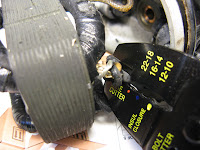 |
| All photos in this entry by Eric from Ottawa |
Eric from Ottawa writes,
[The 15-91 I recently acquired] looks like it's in great shape, but it doesn't run. It has a knee switch rather than a foot pedal and it looks like the motor controller has failed.
To test it, I unscrewed the center of the flywheel so there was no load and plugged it in and got nowhere, even with the knee switch in and fully engaged.
Do you think it's worth re-wiring it to use a standard foot pedal like most of the ones I've seen?
Hi Eric, first off, a little about your machine. The chrome rim on the handwheel plus the design on the faceplate, from the little bit of it that we can see in the photo up top, indicate this machine is from the 1930s or early 1940s (assuming those parts are original). The old-school cylindrical Singerlight visible in the photo below also indicates the machine is from that era.
The “J-“ prefix on the serial number plate indicates your machine was made in Singer’s Canadian plant in Quebec.
Secondly, good on you for trying to run the motor with no load, that’s exactly the correct first step to test out a motor.
As you’ve observed, your machine uses a knee-activated controller.
For those readers unfamiliar with this device, it was an early alternative to the foot pedal most of us know, and it eventually fell out of favor. It consisted of a motor controller placed in the right side of the wooden base:
The end of the removeable knee lever--which stows handily inside the case and underneath the machine, or occasionally up in the domed lid via clasps, when not in use--“plugs” into the hole in the front of the case.
Pressing against the lever would activate the motor controller, which is wired into the inside of the three-pin terminal.
Eric, there are three possibilities here: 1) The power cable is faulty. 2) The motor controller is faulty. 3) The potted motor itself is faulty. Hopefully it is #1 or #2 and not #3, as the first two are easy, relatively inexpensive fixes.
To see if it’s the power cable, try turning the light on. That’s not a 100% accurate test because the bulb may be burnt out, but at the very least, if the light does turn on you know there’s power flowing through the cable. Another thing you can do is bring your cable to the house of a friend with a vintage Singer--that cable will fit a variety of machines made in the 1930s, ‘40s, ‘50s and some in the ‘60s--and see if it powers his/her machine okay. If you determine your cable is what’s faulty, you can order a replacement from Sew-Classic for US $7.95 right here. If you choose to go with a different supplier, perhaps someone local to you in Canada, note that you’re looking for a “single-lead” (as opposed to “double-lead”) cable.
If the motor controller is the problem, it is totally “worth re-wiring it to use a standard foot pedal,” to answer that question, and the good news is that it doesn’t quite require “re-wiring.” The motor controller leads are easily removed via two thumbscrews inside the three-pin terminal. There’s no cutting of wire or soldering required, it’s a simple mechanical connection. To see how to remove the leads, click here and look at the parts of the entry that pertain to removing the two motor leads, which in your case are really the controller leads. Be sure to note which two pins in the terminal those leads connect to.
To replace your motor controller with a foot pedal, you’ll need to spend a tad more. You’ll need to buy a foot controller; the least expensive offered by my preferred supplier, Sew-Classic again, goes for US $11.95.
What you can do is connect the two leads from your new foot pedal to the same two posts that you disconnected the original motor controller leads from. Then you can remove the old motor controller (attached via screws) from that compartment on the right of the wooden base, and store the pedal there.
Alternatively, if you’d like an original Singer foot pedal, you can check eBay.
If it’s the motor that’s bad, then you’ve got a fair amount of work ahead of you to figure out what exactly is wrong with it, and if it’s fixable. You may want to browse the complete “How to Re-Wire a Potted Motor” to determine how to disassemble the motor so that you can inspect the wiring, one possible culprit. But if it’s something beyond bad wiring--a burnt-out field core, for example--that’s beyond the range of my fix-it knowledge.
If you do determine the potted motor is what’s faulty, you will occasionally spot someone selling one on eBay.
Whatever you do, please don’t throw that motor controller out, even if you determine it’s bad; if you stay in this hobby long enough, you will eventually encounter someone else who may need a part from that controller--even if it’s just a single screw--so you may be able to help them rescue an otherwise non-functioning machine. Ditto with the knee lever.
Best of luck with it, congrats on the machine--I love those chrome-rimmed handwheels!--and let us all know how it turns out.































